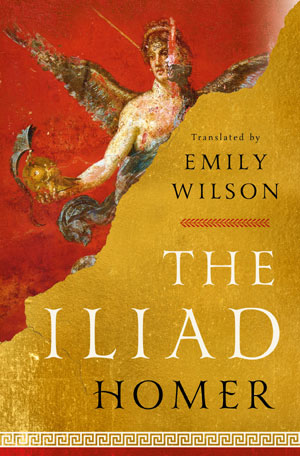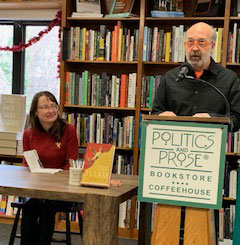|
For
twelve
weeks, the
Steiny Road
Poet read
and
discussed
with her
poetry
reading
group Emily
Wilson’s
translation
of
Homer’s The Iliad.
 Remarkably, the day after (January 7, 2024) the discussion
of the final two sections of this classic work (Books 23 and
24), Washington DC’s independent bookstore Politics &
Prose hosted Emily Wilson who recited the opening
paragraph of The Iliad in ancient Greek and in her English
translation to an overflow crowd that, once her discussion
and Q&A were done, lined up for book signing that
expanded out of the store onto Connecticut Avenue. Remarkably, the day after (January 7, 2024) the discussion
of the final two sections of this classic work (Books 23 and
24), Washington DC’s independent bookstore Politics &
Prose hosted Emily Wilson who recited the opening
paragraph of The Iliad in ancient Greek and in her English
translation to an overflow crowd that, once her discussion
and Q&A were done, lined up for book signing that
expanded out of the store onto Connecticut Avenue.
Steiny estimates an audience of 200 people.
TRANSLATION APPROACH TO THE ILIAD
To prepare for this event, Steiny read Wilson’s “Translator’s Note”. Much
to Steiny’s delight Wilson describes her approach to translating The Iliad in
the same way scholars of Gertrude Stein’s Tender Buttons advocate how to
approach it—read the work out loud to hear its vitality. Wilson’s first
priority was to pay attention to sound. She emphasized the work came
from the oral tradition.  The importance of sound came across when Wilson
recited the opening words of The Iliad. Her English
translation adheres to iambic pentameter (five
pairs of unstressed and stressed syllables: da DUM
da DUM da DUM da DUM da DUM) while the
Greek original employs dactylic hexameter (a more
complicated pattern of long and two short syllables
occurring six times but allowing for variations that
include a long and only one short syllable or two
long syllables). Dactylic hexameter is part of the Greek tradition of heroic
storytelling as iambic pentameter has traditionally been employed to
structure epics in English. The importance of sound came across when Wilson
recited the opening words of The Iliad. Her English
translation adheres to iambic pentameter (five
pairs of unstressed and stressed syllables: da DUM
da DUM da DUM da DUM da DUM) while the
Greek original employs dactylic hexameter (a more
complicated pattern of long and two short syllables
occurring six times but allowing for variations that
include a long and only one short syllable or two
long syllables). Dactylic hexameter is part of the Greek tradition of heroic
storytelling as iambic pentameter has traditionally been employed to
structure epics in English.
Wilson emphasized that The Iliad is understandable because of its
predominant use of short words and its sparingly assigned multisyllabic
words. Look at the opening lines of her translation and notice words
like cataclysmic and immeasurable. Wilson also points out that Greek
names, like Agamemnon, are often multisyllabic.
Goddess, sing of the cataclysmic wrath
of great Achilles, son of Peleus,
which caused the Greeks immeasurable pain
and sent so many noble souls of heroes
to Hades, and made men the spoils of dogs,
a banquet for the birds, and so the plan
of Zeus unfolded—starting with the conflict
between great Agamemnon, lord of men,
and glorious Achilles.
GERTRUDE STEIN’S APPROACH TO TENDER BUTTONS
Typically, Stein used simple Anglo-Saxon words. Her goal was to
communicate clearly so that any person could understand her work.
In Tender Buttons, she also used multisyllabic words sparingly, which gives
them emphasis. In the opening stanza of “Roastbeef.” (the first subpoem in
the second section “Food”), a lyric passage that employs many ing words
that effects a rocking sensation and a musicality typical of Stein, she
also points us to the five-syllable word discrimination with
these tion words: resignation and recognition.
ROASTBEEF. [stanza 1]
In the inside there is sleeping, in the outside there is reddening, in the
morning there is meaning, in the evening there is feeling. In the
evening there is feeling. In feeling anything is resting, in feeling
anything is mounting, in feeling there is resignation, in feeling there is
recognition, in feeling there is recurrence and entirely mistaken there
is pinching. All the standards have steamers and all the curtains have
bed linen and all the yellow has discrimination and all the circle has
circling. This makes sand.
THE MEANINGFUL CONNECTED MULTISYLLABICS
In both examples, the multisyllabic words are meaningfully connected.
Wilson’s translation of The Iliad with the words cataclysmic and immeasurable forecast Achilles unstoppable and irreplaceable loss when
Patroclus, his best friend from childhood, is killed by the mighty Trojan
warrior Hector. Stein’s use in “Roastbeef.” of resignation and recognition
as pointers to discrimination might speak to how Stein and her chosen life
partner Alice Toklas had to be resigned to hiding their love relationship
because if it was seen in public (recognized), discrimination against them,
either judicial or societal, would ensue. No doubt other interpretations
about what Stein might mean are infinitely possible.
SCALE, PERSPECTIVE, POINT OF VIEW IN THE ILIAD
Other characteristics Wilson paid attention to were scale (e.g., how big or
small), perspective, and point of view. All these characteristics also pertain
to Stein’s handling of Tender Buttons which Steiny lumps together as
Gertrude Stein’s cubist approach, a modern art philosophy which
encompasses scale, perspective, and point of view.
In The Iliad, one unforgettable example of scale, immensity as opposed to
minuteness, occurs in Book 2 which catalogues the armies and their
chariots. Scale is also seen between the gods and mortals relative to
longevity (gods never die) and heroics (only mortal can attain heroic glory
because gods never risk dying).
Perspective and point of view go together. Point of view is who tells the
story and perspective is that character’s version of the story. What is
remarkable about The Iliad is for as much as this is the story of Achilles’
rage for how he was humiliated by Agamemnon, the top leader of the
Greek armies, Homer allows their most formidable enemy Hector a scene
where Hector tells his wife that he cannot stay inside the walls of Troy, that
he must show himself to his enemy and risk dying. It’s a tender family
portrait involving a concerned husband, terrified wife, and infant son who
gets frightened by seeing his father in his battle helmet.
In her translator note, Wilson discusses these aspects of The Iliad and the
challenges she faced in honoring the original Greek which included
choosing words that were easy to understand (after all The Iliad was told
by storytellers, not handed down in books) and didn’t make the listener
bored. The characters also needed to come across as individuals,
something she said did not happen in most English translations.
MAGNIFYING STEIN’S CUBIST APPROACH
To understand Stein’s cubist approach, Steiny suggests looking at “Eye
Glasses.”, a 15-word subpoem of Tender Buttons “Objects”. Like the other
subpoems of Tender Buttons, “Eye Glasses.” is abstract and subject to many
interpretations or perspectives, which affects who the narrator might be
and the scale of the story being told.
Eye Glasses.
A color in shaving, a saloon is well placed in the center of an alley.
One way of approaching “Eye Glasses.” is through the aid of magnification
(eye glasses), the narrator sees possibly blood (red color) coming from
some nick caused by shaving with a razor. The poem seems set back in time
in a town in western America where a saloon (not a hair salon, saloon
comes from salon and both indicate a large room) is located in the middle
of a narrow passage (alley). Why the narrator seems to be shaving in a
place where one normally drinks alcoholic beverages is not clear. Is the
narrator making a spectacle of himself? That is, is he putting himself on
display? This brings up the word spectacles, a synonym of eye glasses.
Whose face is this under the blade (of the shaving razor)? Is this narrator
Gertrude Stein (she considered herself a male persona) trying to carve out
new literary territory as an American writer, a writer intent on making a
legendary name for herself? Could this tiny subpoem of Stein’s larger love
poem to Alice Toklas be some kind of coded sexual message? Hiding seems
implied, in that a saloon is oddly “well placed” in the middle of an alley
instead of being out on the main street where all the traffic is. In Tender
Buttons, it’s all a matter of scale, point of view, and perspective as to what
can be seen and whether it is on a physical plane of the body or a mental
plane of the mind.
STEIN’S LITERARY INFLUENCERS
Academics have often stated that Stein made no literary allusions, but
Steiny has noted the influence that Walt Whitman, William Shakespeare,
and Herman Melville had on Tender Buttons. This influence appears in
Stein’s work as a suggestive pointing. For example, Stein begins the
subpoem “Way Lay Vegetable.” (from Tender Buttons “Food”) with “Leaves
in grass” which hints at Walt Whitman’s Leaves of Grass. Just in case you
are wondering, there are other hints in Tender Buttons of Whitman also,
but the reader is required to accumulate and interact with Stein’s texts to
understand this.
COULD TENDER BUTTONS BE AN EPIC POEM?
Steiny believes that Stein also reached back in time in writing certain of her
other texts and possibly had some notion that Tender Buttons would be
her epic poem not unlike The Iliad. Certainly, there is enough violence
in Tender Buttons. What comes quickly to mind is “A white hunter is
nearly crazy.” Take this seriously in a work where images of the Lincoln
assassination (“A Chair.”) come into view from this mostly abstract work.
HOMER AT THE HEART OF GREAT WESTERN LITERATURE
While Gertrude Stein did not have opportunity to read the wonderfully
accessible translation of The Iliad by Emily Wilson, Stein certainly had
ample access to such English translations as the tight poetics of Alexander
Pope’s translation which was based on Latin and French versions. Wilson’s
translation based on ancient Greek is without rhyme but has metric
regularity that pleases the ear. As to hearing the translator in person,
Steiny basked in Emily Wilson’s electrifying passion for The Iliad and now
understands more fully why Homer’s masterpiece is at the heart of great
Western literature.
|